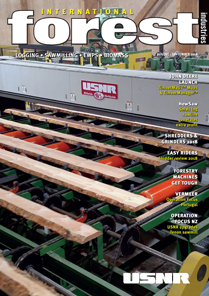EDITOR’S COMMENT ISSUE 67 FEB/MAR 2019
Mixed outlook for forest products in 2019
I was asked recently for my view on global markets for this year and, while it’s always flattering to be asked for opinion, providing a meaningful response felt close to a mission impossible.
In one sense, the outlook appears good, underpinned by an encouraging global GDP forecast of 3.6%, which in theory should see demand for wood products in general push forward materially.
Indeed, this is the expectation of wood industry research group, Wood Markets, which is expecting consumption of softwood lumber to grow by an impressive 2.8% – 350 million m3 – in 2019 having recorded growth of 2.1% last year and 1.9% in 2017.
The overall strengthening demand trend reflects the likelihood for gains in all major regions, led by the US and China, which are both poised for demand growth of 7%, according to Wood Markets. Canada and “some European nations” were expected to record “moderate growth”. Japan was among a handful of poorly performing jurisdictions.
Pricing is also likely to move higher if the firm’s forecasts for global supply are accurate and the fundamentals of supply-demand economics hold up.
Wood Markets has a 2018 supply forecast that attempts to keep track with demand but, at 2.4% (342 million m3), is almost half a percentage point adrift, implying a deficit is on the cards.
The research group suggested US production would continue to rebound and have a “sustaining influence” on production elsewhere in the world.
“Our forecast calls for an impressive gain of up to 4.5% in the US and little advancement in Canada, with the latter potentially diminished by the outcome of US import duties”, the firm stated.
Wood Markets was forecasting the continuation of a difficult period for Canada, with the increased tariffs imposed by its formerly friendly neighbour set to coincide with a fall in value for British Columbia timber, effected by mountain pine beetle. Japan, again, was the only country likely to post a negative number.
That supply summary from Wood Markets provides the first hint of the potential disruptors for this rosy outlook – the Donald Trump-led protectionist trade policy. Though most countries were disappointed by the US policy, from a global perspective it was not the worst thing in the short-term, as the US led a resurgent macro economy and, over the first half of last year, growth reached 4%.
By the second half of the year, though, Trump’s short-term measures were fading and this year economists at Morgan Stanley, among others, are expecting a continued decline in the face of “tighter labour markets, fading fiscal stimulus and the absence of monetary accommodation”.
This wouldn’t be such a concern if Trump were a logical policy maker and could be relied upon to see the writing on the wall and change course. But he’s not, and he can’t.
The trade war with China then becomes a critical determinant of global and wood industry fortunes. China – already slowing considerably from its halcyon days a decade ago – will be further curtailed if the US persists along its current course.
Meanwhile, Europe remains under pressure due to not only Brexit but tensions in Italy and in France that undermine confidence and investment in the Eurozone.
And, on top of this, the world is on the cusp of a debt crisis, with federal banks unable to further leverage their favourite monetary policy tool – interest rates – should that crisis eventuate.
Whether heavy rains will fall from any or all of these dark clouds cannot be modelled into forecasts. And, so, while the numbers may look good right now, I’d prefer to reserve judgement.
Enjoy
Chris Cann




